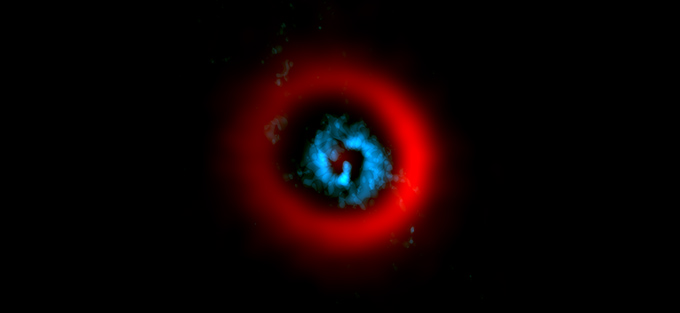Astronomers Found Spirals Inside a Dust Gap of a Young Star Forming Disk
15 May, 2017 / Read time: 3 minutes
Scientific Paper ALMA Kids PublicationPlanets form within disks composed of dust grains and gas. Planets can gather dust grains from their orbits, resulting in dust gaps or cavities, and can also cause spiral waves within the parental disks based on theoretical predictions. To understand where and when planets can form at early stages, ALMA’s capability of seeing disk material with high resolution can depict smoking-gun evidence of infant planets hidden in disks.
Both dust gaps and spirals have been seen separately in a handful of disks. The new ALMA images of AB Aurigae clearly depict gas spirals inside a wide dust gap. These first reported gas spirals within a dust gap might indicate that there are at least 2 planets within this system. One planet at a distance of 80 astronomical units (au; the distance between the Sun and Earth) from the star is required to create the sharp dust ring. An additional planet at 30 au or closer from the star is required to produce such spirals.
These gas spirals further provide an additional dimension to our understanding of planet- disk interaction. Spirals previously seen in the near infrared image appear at the inner edge of the newly detected gas spirals. This can happen when the gas spirals are puffed up and thus scatter more stellar light at locations closer to the star. The kinematics of gas within the spirals mostly follows the disk rotation. It is only at the putative planet location at 30 au from the star that gas has higher velocities, suggesting streaming motions near the planet.

Additional information
This research is presented in a paper titled “Planet Formation in AB Aurigae: Imaging of the Inner Gaseous Spirals Observed inside the Dust Cavity” by Y.-W. Tang et al., published in the Astrophysical Journal
The Atacama Large Millimeter/submillimeter Array (ALMA), an international astronomy facility, is a partnership of the European Organisation for Astronomical Research in the Southern Hemisphere (ESO), the U.S. National Science Foundation (NSF) and the National Institutes of Natural Sciences (NINS) of Japan in cooperation with the Republic of Chile. ALMA is funded by ESO on behalf of its Member States, by NSF in cooperation with the National Research Council of Canada (NRC) and the National Science Council of Taiwan (NSC) and by NINS in cooperation with the Academia Sinica (AS) in Taiwan and the Korea Astronomy and Space Science Institute (KASI).
ALMA construction and operations are led by ESO on behalf of its Member States; by the National Radio Astronomy Observatory (NRAO), managed by Associated Universities, Inc. (AUI), on behalf of North America; and by the National Astronomical Observatory of Japan (NAOJ) on behalf of East Asia. The Joint ALMA Observatory (JAO) provides the unified leadership and management of the construction, commissioning and operation of ALMA.
Contacts
-
Ya-Wen Tang
Institute of Astrophysics and Astronomy
Academia Sinica
Phone: +886-2-2366-5430
Email: [email protected]
-
Nicolás Lira
Education and Public Outreach Coordinator
Joint ALMA Observatory, Santiago - Chile
Phone: +56 2 2467 6519
Cel: +56 9 9445 7726
Email: [email protected]
-
Masaaki Hiramatsu
Education and Public Outreach Officer, NAOJ Chile
Observatory, Tokyo - Japan
Phone: +81 422 34 3630
Email: [email protected]
-
Richard Hook
Public Information Officer, ESO
Garching bei München, Germany
Phone: +49 89 3200 6655
Cel: +49 151 1537 3591
Email: [email protected]
-
Charles E. Blue
Public Information Officer
National Radio Astronomy Observatory Charlottesville, Virginia - USA
Phone: +1 434 296 0314
Cel: +1 202 236 6324
Email: [email protected]

